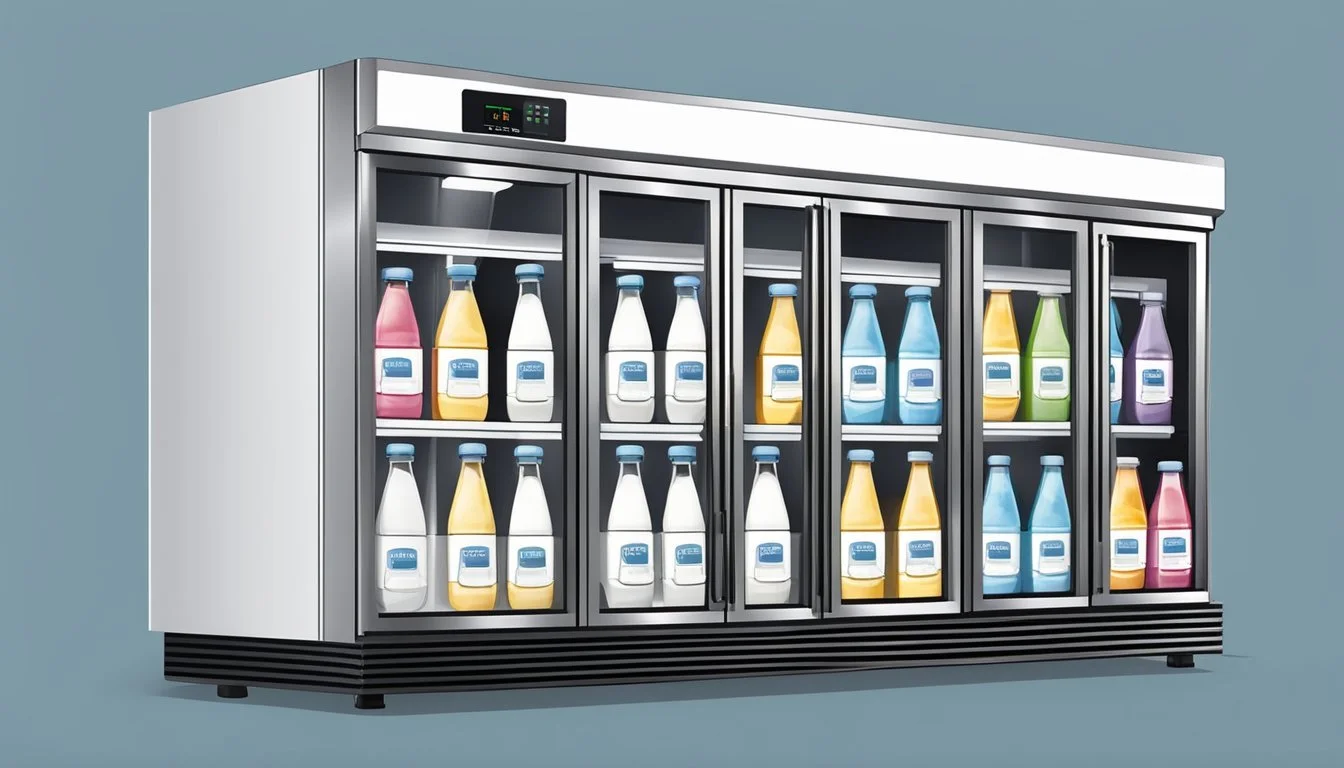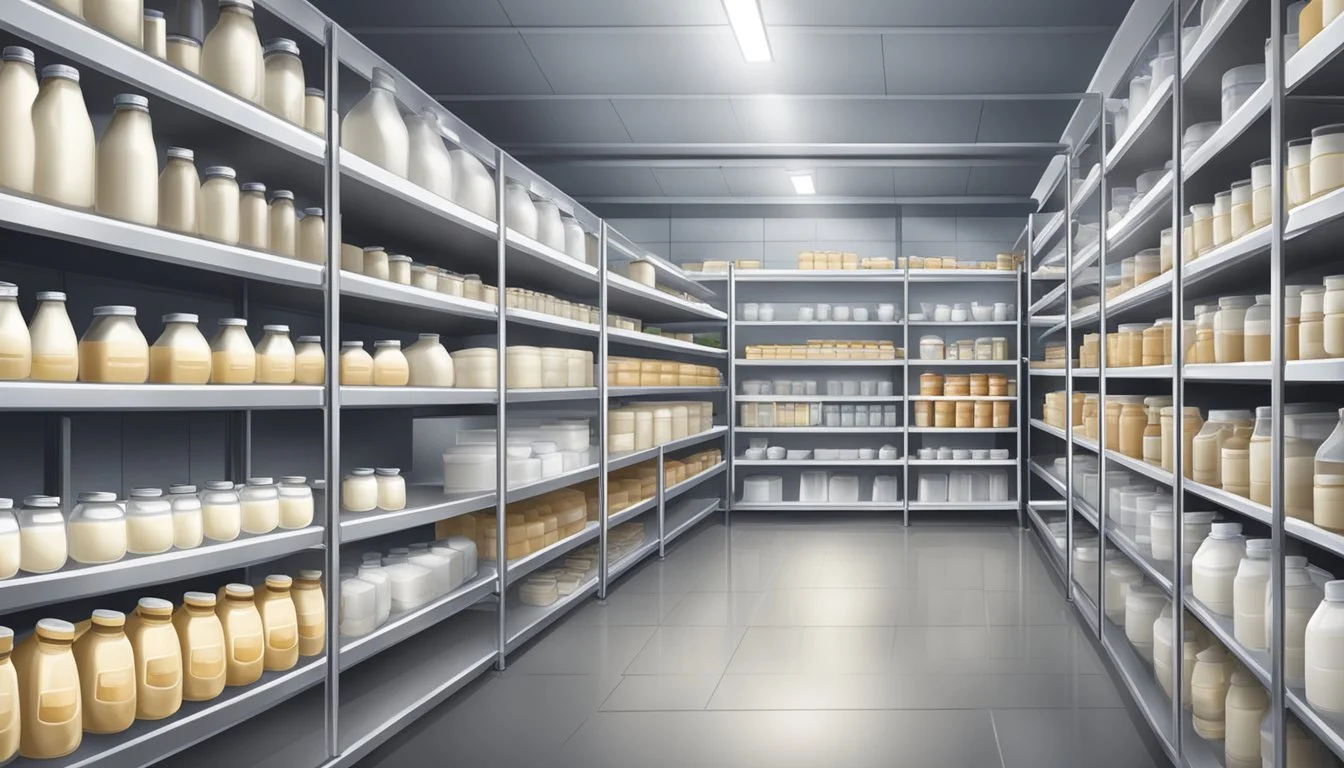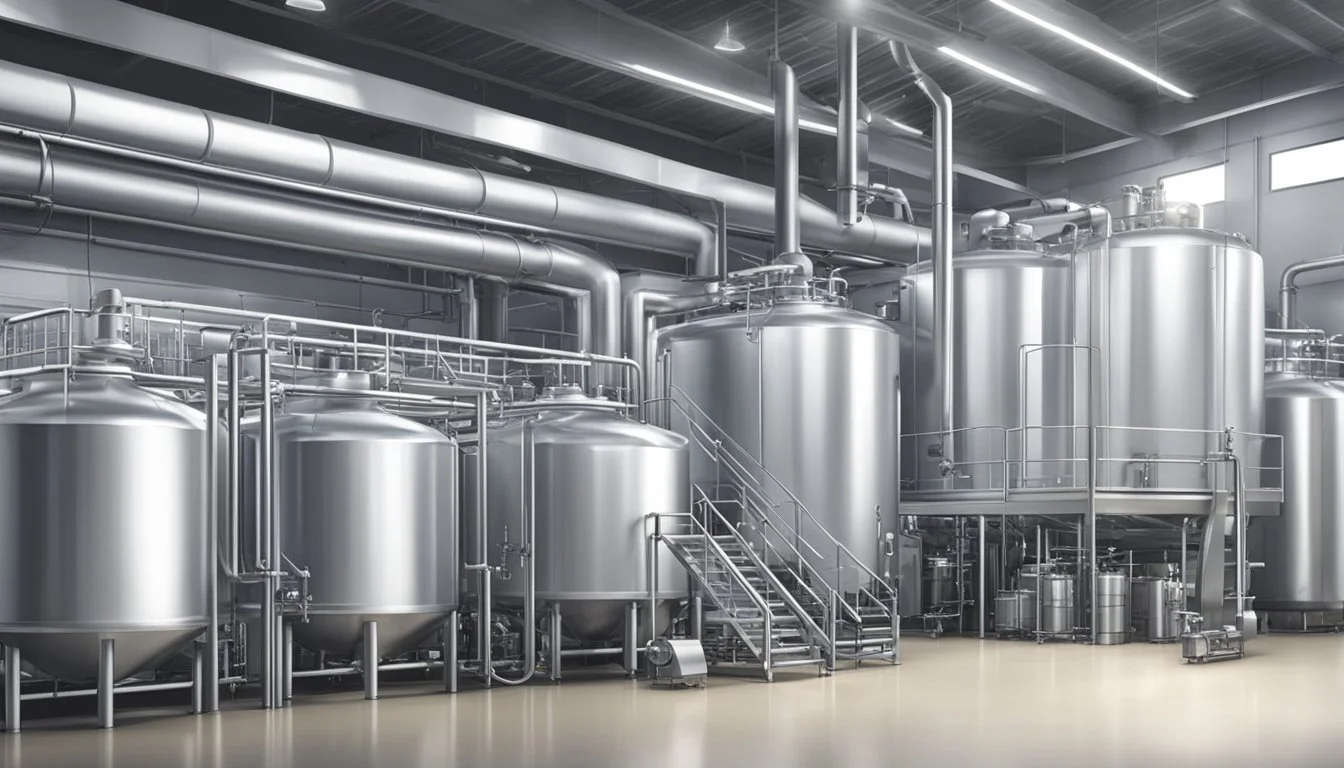Raw Milk Storage Solutions
Ensuring Optimal Freshness with Expert Tips
Preserving the freshness of raw milk is essential for those who choose it for its unaltered nutrients and unique flavor. Unlike pasteurized milk, raw milk has not undergone a heat process to kill bacteria and other microorganisms, which means it must be stored with careful attention to temperature and cleanliness to maintain its quality and safety. Consumers and producers of raw milk prioritize storage methods that maximize the milk's freshness while minimizing the growth of bacteria.
Refrigeration is the cornerstone of raw milk storage, as temperatures between 38°F to 40°F (3°C to 4°C) are optimal for slowing bacterial growth. To ensure that raw milk retains its fresh taste for as long as possible, it must be cooled quickly after milking and kept consistently cold. Moreover, when transporting raw milk, using insulated bags with ice can bridge the gap between purchase and home refrigeration, further preventing temperature fluctuations that hasten souring.
Freezing raw milk is another solution for extending its shelf life, suitable for long-term storage. However, the process of thawing must be properly managed to prevent any quality degradation. Storing raw milk in clean, airtight containers is also critical, as exposure to air can introduce contaminants and accelerate spoilage. By following these best practices, consumers can use raw milk with confidence, enjoying its benefits without compromising on health and safety.
Raw Milk Storage Solutions play a pivotal role in preserving the integrity and freshness of this wholesome dairy product, ensuring that its valuable components are safeguarded for consumption and utilization in various applications, including raw milk traditional medicine. These solutions are designed to maintain the inherent nutritional properties and the diverse array of microorganisms that constitute the intriguing raw milk microbial world.
In addition to facilitating safe storage, these solutions contribute to the continuation of raw milk consumption stories, enabling individuals to savor and benefit from raw milk while upholding the highest standards of safety and quality. Furthermore, adherence to ethical guidelines in raw milk storage underscores the commitment to maintaining transparency, sustainability, and responsible practices, aligning with the principles of raw milk ethics.
As the population continues to age, efficient raw milk storage solutions become increasingly essential in catering to the diverse needs and preferences of an aging population seeking to incorporate raw milk into a balanced and wholesome raw milk diet. These solutions ensure that the nutritional benefits of raw milk remain accessible and viable for individuals of all ages, contributing to their overall well-being and dietary requirements.
Understanding Raw Milk
Before delving into the specifics of raw milk storage, one must understand what raw milk is and the juxtaposition of its potential health benefits with its associated risks.
Health Benefits and Nutrient Preservation
Raw milk is prized for its rich nutritional profile, which includes a variety of nutrients and enzymes that can be beneficial to the immune system. It is a source of beneficial bacteria, proteins, and is believed to retain more of its natural nutrients, such as vitamins and enzymes, in comparison to pasteurized milk, which undergoes heat treatment. These enzymes, like lactase, are thought to aid in the digestion of lactose, potentially making raw milk easier to digest for some consumers.
Nutrient Benefit Proteins Aid in repair and growth of tissues Enzymes Assist in digestion and metabolic processes Beneficial bacteria Support immune system and gut health
Potential Risks of Raw Milk Consumption
While the health benefits of raw milk are often highlighted by proponents, it is important to address the potential risks. Raw milk can harbor dangerous pathogens, such as Salmonella, E. coli, and other foodborne illnesses. Without pasteurization, which kills harmful bacteria, consumers of raw milk are at a higher risk of contracting illnesses that can severely affect health. The immune system can be overwhelmed by these pathogens, leading to serious health consequences. As such, raw milk's safety relies significantly on the stringent management of dairy herds and clean, rapid, and cold storage methods to minimize the risk of bacterial contamination.
Pathogen Associated Risk Salmonella Gastrointestinal illness and fever E. coli Severe abdominal cramps, kidney complications Other foodborne pathogens Vomiting, diarrhea, and other acute symptoms
The debate over raw milk consumption hinges on balancing the preservation of its nutritional content against the imperative to avoid foodborne diseases. Consumers should make informed decisions, weighing the potential health benefits against the risks of pathogen exposure.
Raw Milk Storage Fundamentals
Storing raw milk properly is crucial for maintaining its freshness and safety. These fundamentals highlight the optimal conditions and practices for preserving raw milk.
Optimal Storage Temperature
Raw milk must be kept at a consistent temperature of 38°F to 40°F (3°C to 4°C) to slow bacterial growth and maintain quality. The refrigerator should be set within this temperature range, and a fridge thermometer can be used to monitor it. It is important to ensure that the milk is placed in the coldest part of the refrigerator, away from the door to avoid temperature fluctuations.
Choosing the Right Containers
Using the correct milk container is vital for freshness. Glass containers are preferred for storing raw milk because they don't transfer flavors and are easier to clean. When using plastic jugs, ensure they are food-grade and BPA-free. Regardless of material, all containers should be clean and sanitized before use.
Importance of Airtight Sealing
Sealing milk containers airtight is important to prevent contamination and the entry of odors from other foods. An airtight container not only preserves the milk's freshness but also extends its shelf life. Whether using screw-top lids or snap-on lids, the seal must prevent any air from entering the milk storage container.
Maximizing Freshness and Quality
To maintain the freshness and quality of raw milk, it is crucial to implement specific cooling and storage practices immediately after purchase. Additionally, freezing may offer a method to extend the shelf life beyond typical refrigeration periods.
Proper Cooling and Storage Practices
Raw milk must be stored at temperatures between 36°F (2°C) and 40°F (4°C) to slow bacterial growth and maintain quality. Consumers should place raw milk on a refrigerator shelf rather than in the door to avoid temperature fluctuations and ensure a more consistent cooling environment. It is essential to use the milk while it's fresh, typically within 7-10 days, keeping in mind that raw milk will naturally sour over time due to the lactase enzyme digesting the lactose.
Extending Shelf Life through Freezing
Freezing raw milk is an effective way to preserve its freshness for future use. To freeze raw milk:
Pour milk into freezer-safe containers, leaving about an inch of space at the top to allow for expansion.
Seal containers tightly and label with the date of freezing.
Thaw in the refrigerator when ready to use; it’s best to consume frozen-thawed milk within 24 hours.
It’s important to note that freezing may cause minimal changes in texture and flavor due to the fat separation. However, this doesn't affect the overall quality, and the milk can be gently shaken to redistribute the fat before consumption.
Safety Precautions in Storage
Storing raw milk safely is essential to minimize the risk of foodborne illness. Precise temperature control and strict hygiene protocols are fundamental to preserving milk freshness and consumer health.
Preventing Contamination
Raw milk should be stored at 38°F to 40°F (3°C to 4°C) to prevent the growth of harmful bacteria. It is critical that storage containers are sealed properly to protect milk from contaminants. Ensuring that storage tanks or containers are not exposed to manure and other environmental contaminants is a key factor in preventing contamination.
Storage Aspect Safety Measure Temperature Control Maintain 38°F to 40°F (3°C to 4°C) Container Sealing Use airtight seals on all storage containers Environmental Exposure Keep away from manure and potential contaminants
Hygiene and Cleanliness
Impeccable hygiene is non-negotiable for anyone handling raw milk. Surfaces and equipment must be sanitized regularly to avoid introducing harmful bacteria into the milk. Storage facilities should implement routine cleaning protocols and workers must adhere to strict personal hygiene practices to ensure the safety of the milk. Regular hand washing and the use of clean gloves can significantly decrease the risk of contamination.
Equipment Hygiene Practice Storage Tanks Regular sanitization with approved cleaners Containers Clean prior to use and after any contamination Personnel Frequent hand washing and wearing of clean gloves
These methods collectively ensure the safety of raw milk from the farm to the refrigerator.
Legal and Best Practices
When considering the storage and distribution of raw milk, it is crucial to adhere to legal standards and established best practices to maintain the safety and quality of the product.
Regulations on Selling and Distribution
Regulations for selling and distributing unpasteurized milk vary significantly by region and jurisdiction. Many countries have strict laws that govern the collection, transportation, distribution, selling, processing, and packaging of milk to ensure public health. Raw milk, being unpasteurized, requires particular attention as it's more susceptible to contamination than pasteurized milk.
In the United States, for example, federal law prohibits the interstate sale of raw milk, but individual states may allow its sale within state borders.
Europe has varying regulations, with some countries allowing sales in vending machines, provided the milk is labeled appropriately to inform consumers of potential risks.
Producers are often required to:
Test: Regularly sample and analyze raw milk to ensure it does not contain pathogens or exceed microbial counts.
Label: Clearly identify and distinguish unpasteurized milk from pasteurized products.
Inform: Educate consumers on the risks associated with drinking raw milk and provide guidance on proper handling.
Educating on Proper Handling and Storage
Educational initiatives are fundamental for both producers and consumers to handle raw milk safely. The key components of safely storing raw milk to maintain its freshness and nutritional value include:
Maintaining constant refrigeration at 38°F to 40°F (3°C to 4°C) to slow bacterial growth.
Ensuring containers are sanitized properly; a 3% Hydrogen Peroxide Solution can be used for jar sterilization to extend the milk's freshness.
Advising consumers to boil raw farm milk before consumption to reduce health risks, particularly for high-risk populations such as children, the elderly, and immunocompromised individuals.
By adhering to these guidelines, the risk posed by harmful chemicals and bacteria can be significantly mitigated. It's also important for those involved in the supply chain of organic milk and other processed dairy products to follow these best practices diligently.
Practical Raw Milk Storage Solutions for Farms
Efficient storage solutions are imperative for maintaining the freshness and quality of raw milk on farms. They must ensure that the milk is kept at optimal temperatures from the moment it is collected to the point of sale or processing.
On-Farm Storage Equipment
Farmers typically use refrigerated storage tanks to store the raw milk immediately after collection. These tanks are designed to cool the milk rapidly to a temperature between 38°F and 40°F (3°C to 4°C), which is crucial for slowing bacterial growth and maintaining milk quality. The equipment should be:
Stainless steel: Offers durability and easy sanitation.
Adequately sized: To handle the volume of milk produced, allowing for peak times of collection.
Equipped with agitation systems: To keep the milk evenly cooled and prevent the separation of cream from the liquid.
The choice of equipment will depend on the farm's output. For smaller farms, bulk milk coolers may suffice, while larger operations might require more sophisticated chilling systems.
Managing Storage Space and Size Needs
Space optimization and scalability are key concerns when managing storage for raw milk. Farms must consider their current and future size needs to ensure they have adequate capacity. This includes:
Dedicated space for freezer storage: To extend shelf life if needed, though raw milk is ideally stored fresh.
Planning for expansion: With modular storage systems or room for additional tanks.
Efficient layout: To facilitate the easy transfer of milk from collection to storage, processing, or transportation.
When storing products like cream, butter, and sour cream, which may be processed on-site, a section of the refrigerated storage should be allocated with appropriate temperature settings specific to these products.
Strategic planning of storage solutions directly impacts the economic success and operational efficiency of a dairy farm, ensuring that fresh, high-quality raw milk is available for further distribution or processing.
Additional Raw Milk Products
After raw milk is safely stored, it can be transformed into a variety of dairy products, each requiring specific handling to maintain freshness and quality.
Handling Cream, Butter, and Other Derivatives
Cream: Once separated from raw milk, cream should be kept refrigerated at 36-40°F (2-4°C). It maintains its freshness for roughly one week. Use airtight containers to prevent absorption of other flavors and odors.
Butter: Freshly churned raw milk butter should be stored in the refrigerator and ideally used within two weeks. It should also be kept in an airtight container to protect its taste and texture from the surrounding environment.
Sour Cream: Made by fermenting cream from raw milk, sour cream should be stored in the refrigerator, in a tightly sealed container. It will typically last for up to two weeks, with the sourness intensifying slightly over time.
Advanced Topics in Raw Milk Storage
This section delves into the latest advancements in technology that ensure raw milk's freshness and examines the nuanced shifts in milk's chemical makeup during storage.
Innovations in Milk Storage Technology
Advancements in milk storage technology focus on improving shelf life and preserving raw milk's nutritional value. Hyperbaric storage has emerged as a notable innovation, which involves storing milk at high pressure (50-100 MPa). Studies show that raw milk preserved under hyperbaric conditions at varying room temperatures for up to 60 days can maintain quality comparable to that of traditional refrigeration. It provides a new avenue for dairy farmers who require an alternative to refrigeration, especially in resource-limited settings.
Milking equipment has also seen enhancements in both design and materials. The goal has been to strike a balance between efficiency in milk extraction and ease of cleaning to minimize the risk of contamination. Modern systems feature stainless steel components and advanced cleaning protocols, ensuring that the equipment does not compromise milk quality.
Understanding Milk Composition Changes
Milk's freshness is greatly influenced by its composition which changes during storage. A critical component of milk that's affected during storage is the endogenous enzyme activity such as lactase, which gradually digests lactose leading to a natural souring of milk over time. It is imperative for storage solutions to consider how to control these changes to extend milk's usability.
Monitoring tools like fridge thermometers are essential in managing raw milk's quality during storage. They ensure temperatures are consistently kept between 38°F to 40°F, which is crucial in slowing down bacterial growth and enzyme activity that could otherwise compromise the milk. Furthermore, regular assessment of the milk's titratable acidity provides farmers with immediate data to understand the quality of their product during storage, allowing for more informed decisions regarding milk handling and processing.
Conclusion
Storing raw milk properly is crucial for maintaining its freshness and nutritional quality. Refrigeration at 38°F to 40°F ensures a slower bacterial growth, allowing for an extended shelf life. Freezing is a viable option for long-term storage, although one should be aware that it can alter the milk's texture and taste upon thawing.
Those utilizing raw milk must prioritize cleanliness to prevent spoilage. Sanitizing containers, preferably with a 3% Hydrogen Peroxide Solution, is recommended for maintaining optimal freshness. One should also be mindful of the "best buy" date as raw milk can sour over time due to lactase activity.
Fresh, unprocessed raw milk offers a range of health benefits, but its consumption comes with responsibilities. Adhering to these best practices ensures that individuals can enjoy raw milk's potential benefits while minimizing risks:
Keep refrigerated between 38°F and 40°F
Freeze for long-term storage
Sanitize containers thoroughly
Monitor the "best buy" date to assess freshness
Following these guidelines will help maintain the quality and safety of raw milk for consumers who choose to include it in their diet.









